
LAUREL CANYON

“A winding, inviting . . . portrait of a bohemian quarter that played a prominent role in the foundation of rock music.”
—Dave Itzkoff, The New York Times Book Review
“Hilarious and true and bittersweet. Michael Walker catches the mood in the air, and gets it right . . . A beautifully written document of that time and place when the personalities were as big as the dreams that fueled some of the greatest masterpieces in rock.”
—Cameron Crowe
“Likely the definitive account of this locale and its impact on pop music and culture . . . A fun, dishy read.”
—Christopher Schobert, The Buffalo News
“Michael Walker’s book operates off the intriguing premise that there was something psycho-geographically special about [Laurel Canyon] that helped create the Byrds and Crosby, Stills and Nash. His historical framing devices add depth, whether he’s writing about the liberated ‘ladies of the canyon’ of the Sixties upsetting social conventions, or the fact that Ulysses S. Grant and Pope Leo XIII were both ‘partisans of a cocaine-laced wine called Vin Mariani.’”
—Rolling Stone
“[A] music-focused social history of the period . . . Will resonate with boomers who lived through it all.”
—Chris Morris, The Hollywood Reporter
“Meticulously researched . . . Walker is a dogged fact-finder, and the details he assembles here about various members of the L.A. rock royalty constitute essential reading for music fans who’ve always wondered how true to life ‘Our House’ was, or why Zappa abstained from drugs while making records seemingly designed to soundtrack the act of getting stoned . . . His look at the establishment of the business-side infrastructure that now underpins the music industry is fascinating, and he examines Laurel Canyon’s late-’70s decline with a suprisingly unsentimental eye.”
—Mikael Wood, Time Out New York
“Walker takes the loose geographical map of the Canyon and nearby Sunset Strip as the Bloomsbury of the era’s sound and shows how the idyllic hilly enclave became the musical and lifestyle incubator of everyone from the Byrds and the Buffalo Springfield to the entire L.A. singer-songwriter mafia. [He] evokes the magic of the place wonderfully, particularly the mythic birth of CSN.”
—Steve Matteo and Jeff Tamarkin, Harp
“Walker has constructed an . . . interesting Los Angeles–centred history of rock in the ’60s and ’70s . . . Music [has] moved on. The musicians [have] moved out. But as Walker passionately argues in Laurel Canyon, the memory of what the place represented should not fall into a deep pit.”
—Bill Harris, Toronto Sun
“Loaded with anecdotes, insights and observations rendered in crystalline prose that . . . presents a history of what is perhaps Los Angeles’ most renowned music neighborhood . . . conveying with precision and clarity the key turning points in the Canyon’s fortunes.”
—Mark Nardone, Music Connection
“[A] fascinating study of the Los Angeles neighborhood . . . and its relationship to developments in American popular music in the late 1960s and early 1970s. Throughout, Walker makes a strong case for Laurel Canyon being at least as important as San Francisco’s Haight-Ashbury in defining the sound of pop music.”
—James E. Perone, Library Journal
“Offers candid, insightful glimpses of Frank Zappa’s bizarre, brief tenure in early cowboy movie star Tom Mix’s old log cabin; the jangly social and musical interaction of the Byrds, Crosby, Stills, Nash, and Young, and Joni Mitchell; the rise of the singer-songwriter marketing label; and the scourge of casual cocaine abuse that pervaded the era and, soon, much of the rest of Woodstock Nation.”
—Mike Tribby, Booklist
“Laurel Canyon captures all the magic and lyricism of an almost mythological geographical spot in the history of pop music. The book lovingly limns the story of a more melodious time in rock-and-roll when the great talents of the ’60s and ’70s cloistered together in a sort of enchanted valley populated by an all-star cast of characters, including Joni Mitchell, Jim Morrison, Mama Cass, and Brian Wilson.”
—Steven Gaines, author of Philistines at the Hedgerow
“In Laurel Canyon, rock-and-roll history is urban history, California history, American history, global history, through the songs and scandals coming from a canyon on the coast of dreams running through the labyrinthine center of our times.”
—Kevin Starr, Professor of History, University of Southern
California, and author of Coast of Dreams: California on the Edge, 1990–2003